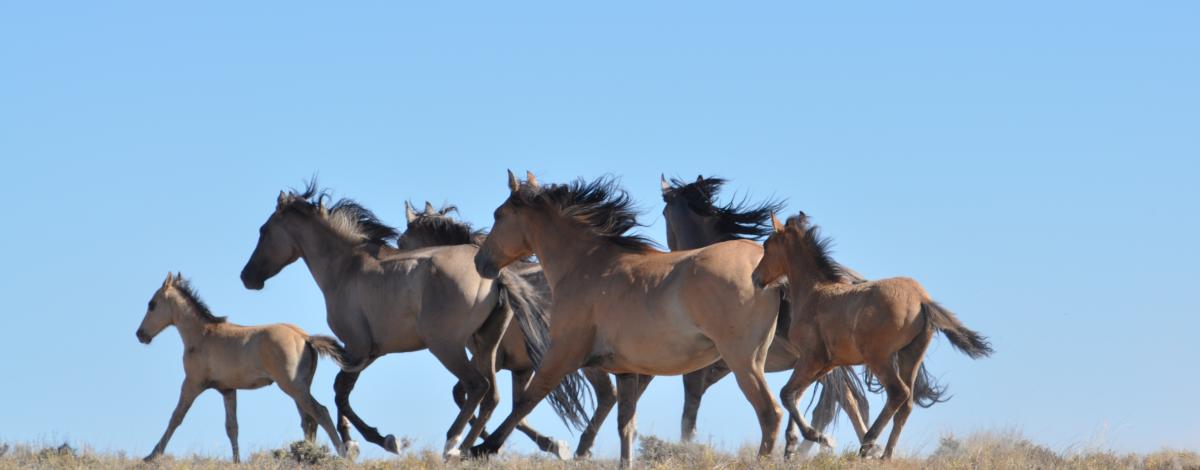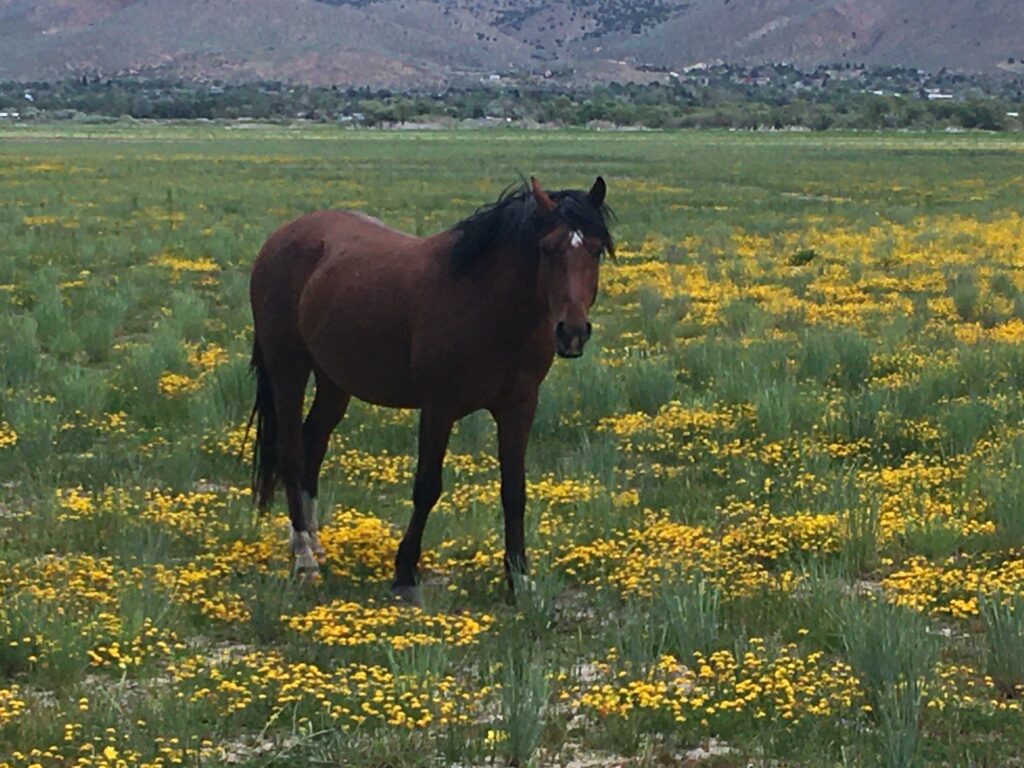The path forward for the restoration of wild horses and burros and their natural habitats

Today in many places all over America, including Nevada, there is a desperate fight — a war being waged between those who appreciate and honor the role of wild, naturally living horses and burros and those who are loathe to admit their fitting place in the world of nature. Many of the latter are people whose lives and goals in life have become too much about control and manipulation of the Great Rest of Life, including all of the marvelous, vast and various species and the diverse natural ecosystems they inhabit.
Many of America’s public lands livestock ranchers fall into this category, but it would be unfair to omit the other segments of our society that have targeted America’s wild horses and burros for herd-crippling reduction and/or alterations in their basic biology. The latter seeks to render them mere tokens, repressed vestiges. Many simply egg for their outright elimination. So many of these people are, as the saying goes, “so full of themselves” and seem to have lost touch with a most important human capacity: the basic humility to admit one has yet much to learn and much improvement to make. They need to ponder a Lakota greeting, one inclusive of horse and burro kind: Mita kuye oyasin — we are all related, meaning all in the great family of life.
We can set life’s “ship of state” upon a different course, though. I refer to the Wild Free-Roaming Horses and Burros Act of 1971 (WFHBA), and its true spirit, meaning and intent. Signed with a glowing sendoff by President Richard M. Nixon, this noble and unanimously passed law was and remains a quantum leap forward for humanity, morally and spiritually as well as ecologically, because it shows that people can truly care about the beings who share this wonderful Earth but are present in slightly different looking bodies and fill slightly different roles within the greater community of life.
Horses and burros are highly evolved, anciently rooted and long-standing presences in North America. Here, not only their species but their genus and even family have inhabited and been positively integrated for millions of years, dating back nearly to the close of the age of dinosaurs. And the plain fact is that we so-called civilized humans wouldn’t be where we are today, were it not for our several-thousand-year partnership with horses and burros. Which leads me to ask: Isn’t it high time we humans do something truly good for them? And what better gift of repayment could we possibly give than to restore them to their rightful land and freedom?
Wild Horse Band from Calico HMA, BLM, Northern Nevada. Winter 2010. Credit and copyright Craig C. Downer.
Their destiny should not be to remain forever the mere slaves of humans, subject to disrespectful confinement and removal from their compatible and age-old habitats! In these ecosystems, they play keystone roles that enhance, embellish, preserve and restore the life home for hundreds, even thousands of fellow, co-evolved and co-evolving creatures and their respective kinds.
But what needs to happen to restore the true intent of the WFHBA? This solution is near and dear to my heart and mind. It is called reserve design, and is akin to rewilding. It is a key tool of modern conservation science, and seeks to restore much-needed knowledge, appreciation and respect for wildlife. I say much-needed because the world is being overwhelmed and over-altered by the self-centered human species. But we can yet correct our course for the good of the horses, burros and their habitats.
Here are some of the basic elements of reserve design
- Carefully study the ecosystem in question, including both natural and human components, to determine where Reserve Design can best work and how it can best be implemented.
- Incorporate natural barriers such as high mountains, deep canyons, or broad or raging rivers wherever possible to act as limits to wild equid expansion into areas where they could be targeted for persecution and elimination.
- Where deemed necessary, construct semipermeable, artificial barriers such as buck-rail, log-&-pole fences. These are very effective in keeping wild horses out of areas where they would come to harm through harassment, capture and removal, or even killing.
- Establish buffer zones around each wild equid reserve with the cooperation of local landowners and government agencies at all levels. This would protect a core area within the reserve that would be left alone and be highly safe for the wild horses and burros and their families. The buffer zone would have the effect of tapering off, or attenuating, wild horse/burro presence as well as that of humans, but in opposite directions. This could be sustained by positive reinforcement and mild forms of adverse conditioning — techniques frequently used by wildlife and citizen conservationists alike. Remember: Horses and burros are intelligent creatures who can learn where they are most safe, and conversely can learn where serious danger threatens their well-being. To accomplish this, professional conservationists, zoologists and ecologists should be given authority to determine the exact dimensions and conditions of any given reserve. This would replace BLM and USFS herd “management” areas/territories, where wild equids’ rights are largely or totally ignored in considerations of habitat resource allocations (AUMs) and population number assignments (AMLs) – often setting these metrics at absolutely zero. Inadequate habitat provision, including lack of forage, water, shelter and other components essential for mustang and burro survival and reproduction are “squeeze plays” that are leading to the decline and likely eventual demise of the last of America’s once great wild horse and burro herds. Add to this unnatural, brutal and invasive means of altering the wild equids’ physiologies reproductive interventions, such as GonaCon, PZP and surgical sterilizations of both females and males as well as unnatural sex ratios skewing toward more males.
- Wherever possible, restore the natural predators of the wild horses and burros, such as pumas, bears and wolves. Recognize that there are many different mortality factors that affect wild equid survival, including diseases, poisonous rattlesnake bites, harsh weather, drought, blizzards, etc., and that when the wild equids pass on in the wild, they contribute their mortal remains to the very ecosystems where they were born, lived out their lives, and died. It is only right and natural that their remains should be used by all the other species, from plants to animals to decomposers who go together to form each unique and interconnected ecosystem. When the bodies of the wild equids are removed from such an ecosystem, either alive or dead, the ecosystem can be seriously diminished. (The WFHBA clearly states that wild horses and burros “are to be considered in the areas where presently found [1971 as year-round habitats] as an integral part of the natural system of public lands”. (When BLM or USFS drastically reduces the equid herds, they upset the natural social structures that limit reproduction. This is a critical function of older stallions and mares, jacks and jennies.)

- Allow the horses and burros to fill their respective ecological niches and naturally self-stabilize within their habitats. This is precisely what is not being allowed to happen by the BLM-USDI and US Forest Service-USDA, and is contrary to the intent of the WFHBA. Additionally, Section 10 of the WFHBA should be activated to establish, by order of either the Secretary of Interior or the Secretary of Agriculture, long-term field studies of wild horse and burro herds and their habitats so that we can learn in greater detail just how these creatures relate and contribute to their ecosystems. The Heber wild horse herd of the Apache-Sitgreaves National Forests in the Mogollon Rim area of Arizona would be an ideal herd for study, as would several other herds including the Montgomery Pass herd on the California-Nevada border: Both herds have a high degree of natural self-stabilization. Concerning the sagacious wild burros, I would recommend as Section 10 study herds, BLM’s Marietta Wild Burro Range in Western Nevada near the California border as well as Arizona’s Black Mountain wild burro herd on BLM lands in and around the old western town of Oatman. I have visited all of these herds and am impressed by their vast, wide-open spaces and rich species biodiversity. (I would be glad to offer BLM and/or USFS professional collaboration on these studies.)
- Develop programs to educate the public about the positive aspects of wild horses and wild burros. These should include information about herds’ naturally restoring degraded ecosystems by: (a) building healthy soils that absorb more moisture, elevate water tables and recharge vital aquifers, (b) dispersing a wide variety of intact seeds of diverse plant species, including many natives with which these equids have coevolved for millions of years, (c) helping other animals and plants by opening up water and food sources during winter and summer extremes, (d) sequestering carbon from the atmosphere, and (e) mitigating and often even preventing catastrophic wildfires.
- Develop win-win relationships between wild horse/burro herds and local human communities by providing supervised volunteer opportunities or even pay in exchange for monitoring and protecting these herds. Also, in order to establish complete and viable habitats for long-term viable herds, establish cooperative agreements to utilize private or other government agency land and resources, as is permitted under Sections 4 and 6 of the WFHBA. Finally, promote moderate ecotourism enterprises. These would guide people from our country and abroad in non-disruptively observing these wonderful creatures in their natural homes together with their symbiotic companion species.
- Foment field biology classes at all education levels to observe and investigate wild horses and burros and their respective habitats in a respectful and non-invasive way. These would be spread out over many areas where wild horses and burros live so as not to overly affect any particular herd. The ecotours would be similarly spread out.
- Incorporate similar and interrelated steps that would loosen the present stranglehold on public lands by the arrogant and insufferable wild horse/burro enemies, including closure to livestock. We must topple the monopolization of our public lands, on which there are about 100 times more livestock than there are wild horses. Even within the wild horses’ and burros’ legal areas, these national heritage species find themselves at the bottom of the totem pole, receiving only about 10 to 15 percent of the forage, while the rest goes to cattle and sheep ranchers. This outrage is entirely contrary to the WFHBA, which clearly states that legal herd areas (BLM) and territories (USFS) shall be devoted principally to the wild horses and burros themselves.
Adopting reserve design would restore America’s herds to truly long-term-viable levels in the thousands in commensurately viable habitats, including migration routes to and from summering and wintering habitats. Reserve design would rescue these wonderful native species from the present existential crisis, while at the same time doing a world of good for involved people. We must overcome our own – and Nature’s! – worst enemy: our short-sighted, narcissistic self-absorption, and the tendency to human speciesm, or exclusivity at the cost of others.
Craig C. Downer is a wildlife ecologist residing in Minden, Nevada. He can be reached at: [email protected]. He is president of a 501 c 3: Andean Tapir Fund / Wild Horse and Burro Fund that is dedicated to saving/restoring beleaguered species in the Tapir, Horse and Rhino families: Order Perissodactyla and is a member of the IUCN Species Survival Commission.
